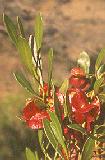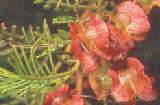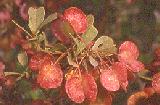In 1754. Philip Miller named this genus Dodonaea after Rembert Dodoens, a 16th Century Flemish botanist, who was professor of medicine in the University of Leyden, Netherlands. At this time, 1754, there are records that Dodonaea viscosa was actually in cultivation in Europe! Dodonaea is predominantly an Australian genus which is well distributed in all states. There are 69 species and 60 of them are endemic to Australia. Most are small shrubs 1-2 m in height, although two species are prostrate, and forms of Dodonaea viscosa can be single stemmed trees of up to 8 metres. Dodonaea may be found in many habitats (e.g., rocky ridges, forest, riverine communities, mallee, woodland and shrubland), however, they are not found in alpine communities, nor in dense vegetation communities such as heathland and rainforest. The common name applied to Dodonaea is "Hop Bushes", because the colourful fruits resemble the fruits used in brewing. Dodonaea is in no way related to the "Hops" (Humulus lupulus) which is used for making beer. The members of the former Dodonaea Study Group usually called them affectionately "Dods". The visual attraction of these plants is their colourful fruits, though well grown specimens in cultivation can be attractive in foliage alone, e.g., D.sinuolata. I have grown a wide range of Dodonaea species here in Tasmania. They are quite hardy plants.
Leaf forms are very variable and are important in identification. In West's revision, there is a general key and a "Vegetative Key" to the species. The latter is very helpful especially when no flowers or fruit are available. Forty-six of the species have simple leaves and 23 species have compound leaves. The leaves are usually alternatively (rarely though sometimes opposite) arranged on the stem. The leaves can be glabrous (without hairs), hairy or in the case of D.glandulosa have glandular hairs. Seedling leaves frequently vary in shape from the adult leaves. The Flowers of DodonaeaThe inconspicuous flowers have no attractant for pollinators and the absence of petals allows the pollen to be dispersed unhindered by the wind. No nectar is produced, which in other plants is an attraction to pollinators. The small flowers lack petals, are quite inconspicuous and usually have a short flowering period. They are rarely used for the identification of species in this genus. The branching system of the inflorescences is spiral or scattered (except in D.ericoides, which has a solitary, terminal flower) and the inflorescences are described as a panicle. Beneath each flower is a bract or leaf-like structure. The size and structure of the flower in each species is similar but they vary in the number of parts, i.e., sepals and stamens. Most species of Dodonaea have male flowers on one plant and female flowers on other plants (dioecious). The female flower may be identified by the single style with its sticky receptive tip and the male flower by a whorl of stamens carrying the pollen. Many of these species may also produce bisexual flowers. Each flower has a small stalk (pedicel) that elongates in the fruit. There are usually 3-6 (sometimes 7) sepals in each flower and they are not joined but are free. The position of the sepals at flowering differ in that, in the male flowers (Fig.1 (a)) the sepals are usually spreading and in the female flowers, the sepals are more erect and surround the ovary and the style (female part - Fig.1 (b)) protrudes from between them. Usually the position of the sepals in bisexual flowers is more like that of the male flowers. There are usually twice as many stamens (male parts) as there are sepals. The pollen producing parts (anthers) are large on usually short stalks (filaments) and are usually twisted at flowering time. There are usually 8-10 stamens, but sometimes less and sometimes more as in D.polyandra which has 12-14. The style is made up of 3-4 sections, which are usually joined in the lower half. The style is retained in the fruits of D.bursariifolia, D.humilis, D.macrossanii, D.petiolaris, D.physocarpa and D.trifida. Propagation by CuttingsThe propagation of these plants by cuttings is relatively easy. They should be taken from the plants with female flowers to ensure the colourful capsules. My method of propagation from cuttings is:
Propagation by Seed
The fruits of Dodonaea are often very colourful and vary a great deal in colour and form. The dry dehiscent capsules have 2-6 valves. Most capsules display an appendage: these can be rounded or transverse wings, or the capsules may be globose with horn-like or lobe-like appendages. Some fruits are also hairy. The fruits usually change in colour from green to brilliant shades of red, pink, purple or brown before maturing. At maturity they turn dry and papery, then split and expel their seeds. The number of seeds maturing in each fruit varies, as does their shape, but they are usually round, black and shiny. Capsules may not contain viable seeds unless grown near a male flowering plant. If there is room, it is recommended that you plant three or four of the seedlings in the one area and this should ensure a better chance of one of the plants producing viable seed. It is best to use seed collected from the wild, as Dodonaea tend to hybridise. Many Study Group members have found that covering the seed with boiling water and leaving overnight before sowing is the best method. I use a mix of 50 per cent coarse sand and 50 per cent peat moss - sieved. The seed after treatment are put on this mix with a light covering of the same seed mix, and placed in the glasshouse where they are watered as required. When the second pair of leaves appear they are potted on into tubes and hardened off in the unheated glasshouse for a week or two before being put outdoors in a sheltered spot. I usually do this in the spring but one January sowing achieved the best rates of germination. Lyn Stewart of South Australia boiled seed of various Dodonaea species in a microwave for a couple of seconds and got 100 per cent germination. A later trial with no pretreatment had reasonable success. She had lots of D.viscosa ssp. angustissima seed, but it looked all shrivelled up and useless. She decided to soak them for a few days, but forgot about them. They became swollen and germinated within a week. Soaking is good for them. A report in May 1984 by CSIRO's Division of Forest Research on hard-seeded Dodonaea was that roughly 80 per cent to 90 per cent germination occurred following boiling water treatment and 90 per cent with nicking the seed using a scalpel on the cotyledon end of the seed. Beverley O'Keefe of Queensland, reported that having collected seed of D.stenophylla from the Tambo Road. She put them in a glass, poured boiling water over them and left them to sit. These were left in the glass and forgotten as they did not seem to swell. About a month later she found that they had put out small shoots (roots) and were potted into tubes. Dodonaea Capsules
Seed Germination TrialsRandy Linke from California (USA) reports on trials of 18 species and varieties of Dodonaea seed. The trials were conducted using different treatments to assess their effect on germination and to see if there was one treatment that worked best on all types. For each species there were three samples of 12 seeds. Each sample was subjected to a different pretreatment and sown in the seed flats in a mix of equal parts perlite and commercial potting mix with a peat base. This was bottom heated at 70oF (21oC). The pretreatment methods were:
From Australian Plants, journal of the Association of Societies for Growing Australian Plants, December 1993. This article is the result of many years study by members of the former Dodonaea Study Group in all parts of Australia. The artistic work in the sketches by Marion Simmons, Karen Stewart and A. Prescott is gratefully acknowledged. The article is based on the work of Judy West, a botanist at the Australian National Herbarium. "A Revision of Dodonaea Miller (Sapindaceae) in Australia" published in Brunonia No 7, 1984 and her revised key and descriptions in Volume 25 of the Flora of Australia.  [Front Page] [Features] [Departments] [Society Home] [Subscribe] Australian Plants online - September 2002 |
||||||||||||||||||||||||||||||||||||||||||||||||||||||||||||||||||||||||||||||||||||||||||||||||||||||||||||||||||||||||||||||||||||||||||||||||||||||










